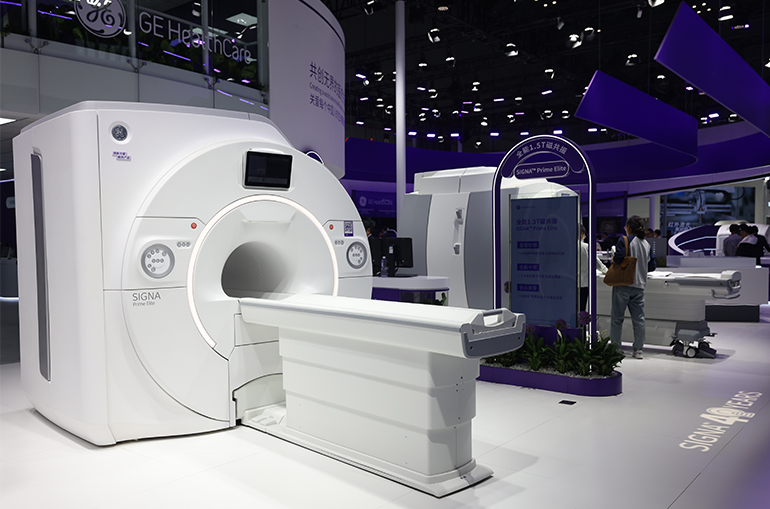 China Remains Competitive Despite Rising Labor Costs, Makers of Medical Devices Say
China Remains Competitive Despite Rising Labor Costs, Makers of Medical Devices Say(Yicai) April 16 -- China is still competitive for manufacturers of medical devices even though labor costs are rising while foreign companies increase the share of locally sourced components in products, according to several executives interviewed by Yicai.
"If we are confident about China’s market potential and supply chain resilience as well as the innovation capabilities of our research and development teams in the country, it will be very clear for us [to stay in China]" because the best opportunity appears when others hesitate, Zhang Yihao, president and chief executive of GE Healthcare China, told Yicai recently.
However, if the firm focuses on labor costs only, such costs are increasing year by year in China, Zhang added. Chicago-headquartered GE Healthcare has six production bases with seven facilities in China, and most of them are located in eastern cities such as Beijing and Shanghai.
"Our plants in China have always been global ones," Wang Hao, president of China business at Siemens Healthineers, said to Yicai. Many of the company’s global products are only produced in Shanghai or Shenzhen and more than half of the products made by the two plants are sold abroad.
China no longer is a country known for low labor costs in this field, Wang said. Incomes are rising and the supply chain has stopped offering cheap products so in some areas of China, production costs have even gradually caught up with those in Germany.
Siemens has four research and development bases and factories in the three coastal cities of Shanghai, Shenzhen, and Wuxi. The firm's core products of CT and MRI devices are mainly produced in Shanghai and Shenzhen.
Multinational corporations need to consider costs across the industry chain including those linked to labor, business environment, innovation, and transportation when they invest in projects, Zhang said. "I cannot say that costs in China are the lowest worldwide but the country is generally very competitive."
"The absolute demand in China has been very good in the past two years although we did encounter some challenges, such as slowing growth," Wang said.
"Efforts must be made in every link," Zhang said, adding that the production costs of GE Healthcare’s new medical devices targeting Chinese counties "will definitely go down" this year.
Cost Pressures Across the Chain
Faced with pressures, cutting costs and increasing efficiency is a common theme for companies in the sector, spreading from upstream to downstream parts of the industry chain.
The plan is to work more closely with the supply chain to enhance global competitiveness through technological innovation, Wang said.
Shen Lixin, head of the Chinese medical division of Drager, held a similar stance. "Next, we need to use China’s domestic supply chain to reduce costs." The German ventilator giant with a production base in Shanghai already sources a significant proportion of components locally.
Producers shift focus to higher-end products. Zhang said that GE Healthcare just located its NMR equipment headquarters for the eastern hemisphere in Tianjin this year and that its top-end product PET-MR will also be produced in the coastal city.
GE Healthcare’s plants in China have started producing many premium products after the Covid-19 pandemic. For example, the Beijing plant is already able to produce PET-CT scanners. The second joint-venture plant between GE Healthcare and China National Pharmaceutical Group started construction in Shenzhen late last year.
"We have done so many things in the past few years. If we were not confident, we would not do these things," Zhang said. The share of locally made products surged to make up 80 percent of total sales in China from around 30 percent in the past three years, he added.
Drager's local production in Shanghai has resumed after geopolitical conflicts, supply chain disruptions, and longer logistics routes adversely affected the output of ventilators in recent years, Shen said, adding that initially, Drager imported all the components from Germany to be assembled in China.
Drager aims to procure all parts locally for the production of ventilators, anesthesia machines, and monitors for medical devices this year, Shen said.
In the future, Drager’s Shanghai factory will become truly international, the executive said, adding that the firm is still hiring people despite the adverse macroeconomic environment.
Complete Supply Chain
"China’s biggest advantage is that it has complete supply chains,” Shen said, adding that the fulfillment rate of procuring components in the Yangtze River Delta region is very high.
"Siemens Healthineers’ local plants are located in China but they do not produce just for China," Wang said. Basically all imaging and diagnostics products sold in China will be produced locally, including the firm’s most advanced 7T MRI, he noted.
Local procurement is key to progress. More than four-fifths of Siemens Healthineers’ suppliers in China are local suppliers. "We will focus more on improving the supply chain, which means higher quality and stability as well as lower costs," Wang said.
"GE Healthcare firmly believes that China’s ecosystem cannot be copied," Zhang said, adding that this does not mean the system should not be improved. "We need to spare no effort to optimize the resilience, cost, quality, and delivery cycle of the supply chain to be the best globally.”
Editors: Tang Shihua, Emmi Laine